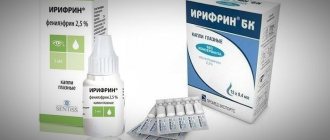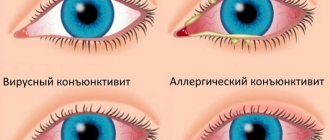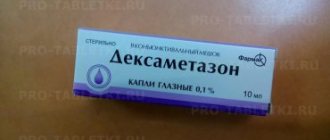Description of the drug
This medication is based on tropicamide, which allows you to dilate the pupil. Used to make the correct diagnosis in ophthalmology. Thanks to this tool, the ophthalmologist can carefully check the fundus of the eye and detect false myopia. In addition to diagnostics, these eye drops have a number of medicinal properties. These include treatment of inflammation in the front of the eye, as well as assistance during laser vision correction procedures.
Also read the instructions for Tropicamide eye drops.
Mydriacyl is used in ophthalmology
It is worth noting that Mydriatsil is well absorbed and its duration of action is relatively short. This is the optimal solution, given the versatility of this product.
The tool acts not only for the purpose of diagnosing diseases of the organs of vision, but also for therapeutic and auxiliary purposes.
Reviews
Reviews of Mydriacyl eye drops are mixed.
Antipova T. M. (pharmacist), 27 years old, Kolomna. Mydriacyl cannot be used systematically. And during treatment with it, the patient should not watch TV, work on a PC, write, read or do other work associated with bright light or eye strain. If the doctor prescribed drops, it is better to install them at night, then you will see better during the day. Veronica (patient), 28 years old, Moscow. I was prescribed Mydriacyl after laser eye correction. I was tormented by eye pain. The doctor explained that they were caused by a spasm of accommodation. The drops helped me get rid of it, so the pain also went away. Evgenia (patient), 42 years old, St. Petersburg. The doctor prescribed Mydriacyl after eye surgery. After using the drops, I developed dryness, discomfort and burning. But I still continued to use the drug. After a week, the side effects stopped and my vision improved.
Midriacil is an eye drop with a persistent but relatively short-term effect. In modern ophthalmology it is preferred. This is necessary for the rapid restoration of visual function after its use. After installing Atropine, this would be impossible, since the effect of the latter persists for several days.
pharmachologic effect
The main pharmacological effect of the eye drops in question is considered to be the ability to expand the diameter of the pupil. This is facilitated by tropicamide. Long-term use of Mydriacyl causes accommodation paralysis and affects the quality of your vision. However, such a result is often necessary so that false or real myopia can be determined. The largest pupil size is noticeable after 20 minutes of instillation of drops. This effect lasts no more than three hours.
Pupil dilation under the influence of Mydriacyl
The main property of this drug is preserved for six hours. Then absolutely all signs of tropicamide exposure disappear.
Mydriacyl is able to expand the size of the pupil to diagnose visual disorders.
Tropicamide
Home Medicines Cycloplegics and mydriatics Tropicamide
| Release form, composition | Dosage regimen | Precautions and Warnings |
| Excipients | Indications for use | Side effects |
| pharmachologic effect | Clinical researches | Drug interactions |
| Pharmacokinetics | Contraindications | Overdose |
Tradename
Monopreparations: Midrum (Chauvin ankerpharm), Tropicamide (Polfa, Rompharm), Midriacil (Alcon). Combined drugs: Appamide plus (Appasamy ocular devices), Midrimax (Promed exports).
Chemical name
: N-Ethyl-3-hydroxy-2-phenyl-N-(4-pyridinylmethyl)propanamide
Molecular Formula
: C17H20N2O2
Molar Mass
: 284.36
CAS Number
: 1508-75-4
Solubility
: Soluble in ethanol (57 mg/ml) and DMSO (57 mg/ml). Practically insoluble in water (
Release form, composition
Midrum - eye drops, 5.0 mg of tropicamide in a 10.0 ml bottle with a dropper. Colorless, transparent, odorless solution.
Tropicamide (Polfa, Rompharm) - eye drops, 5.0 or 10.0 mg of tropicamide in a 10.0 ml dropper bottle or 5.0 ml dropper bottle. Colorless transparent solution.
Midriacil - eye drops, 5.0 or 10.0 mg of tropicamide in a 15.0 ml dropper bottle. Colorless transparent solution.
Appamide plus - eye drops, 8.0 mg tropicamide + 50.0 mg phenylephrine hydrochloride in a 5.0 ml dropper bottle. Colorless transparent solution.
Midrimax - eye drops, 8.0 mg tropicamide + 50.0 mg phenylephrine hydrochloride in a 5.0 ml bottle. Colorless or light brownish-yellow transparent solution.
Excipients
Midrum – benzalkonium chloride, sodium monohydrogen phosphate dodecahydrate, sodium dihydrogen phosphate dihydrate, water for injection.
Tropicamide (Polfa) – benzalkonium chloride, sodium chloride, disodium salt of ethylenediamine intertraacetic acid, hydrochloric acid, water for injection.
Midriacil - benzalkonium chloride (0.1 mg), sodium chloride, disodium edetate, hydrochloric acid and/or sodium hydroxide, purified water.
Tropicamide (Rompharm) – benzalkonium chloride, sodium chloride, disodium edetate dihydrate, hydrochloric acid, purified water.
Appamide plus - sodium chloride, chlorobutanol, disodium edetate, sodium hydrogen phosphate, sodium dihydrogen phosphate, purified water.
Midrimax – benzalkonium chloride (0.1 mg), sodium metabisulfate, disodium edetate, hypromellose, sodium hydroxide, hydrochloric acid, water for injection.
pharmachologic effect
Tropicamide is an anticholinergic drug that blocks the response of the muscular sphincter of the iris and ciliary muscle to cholinergic stimulation, causing pupil dilation (mydriasis) and accommodation paresis (cycloplegia).
Pharmacokinetics
When applied topically, tropicamide, unlike atropine, does not bind to eye tissue. The washout time is less than 15 minutes for an unpigmented iris and 30 minutes for a pigmented one. The maximum mydriatic effect of the drug occurs 20-40 minutes after instillation, and the cycloplegic effect occurs after 20-35 minutes. Duration of action – 3-8 hours. It may take 6 to 24 hours for complete recovery of accommodation.
Dosage regimen
To examine the fundus of the eye, tropicamide is instilled in 1-2 drops of a 0.5% solution 15-20 minutes before the examination. To determine refraction, instill 1-2 drops of a 1% solution 2 times with an interval of 5 minutes. After 20-30 minutes, you can re-drop the drug to prolong the effect.
Indications for use
For diagnostic purposes it is used for fundusoscopy and determination of refraction. Also used in the pre- and postoperative period when short-term mydriasis is required. For medicinal purposes it is prescribed as part of complex therapy for inflammatory diseases of the anterior segment of the eye.
Contraindications
Glaucoma or predisposition to it (for example, narrow glaucoma), hypersensitivity to the components of the drug.
Precautions and Warnings
Patients with severe iris pigmentation may require a higher dose or concentration of tropicamide to achieve the desired therapeutic effect.
Tropicamide may cause an increase in IOP. In this regard, before prescribing, it is necessary to perform tonometry and assess the depth of the UPC, especially in elderly patients.
In individuals with increased sensitivity to anticholinergic drugs, tropicamide-induced psychotic reactions and behavioral disorders may develop.
The drug should be used with caution in cases of arterial hypertension, hyperthyroidism, diabetes mellitus, and heart disease.
Particular attention should be paid to patients susceptible to belladonna alkaloids, as they have an increased risk of developing systemic toxicity.
Tropicamide is used with caution for conjunctivitis due to increased systemic absorption of the drug.
A 0.5% solution of tropicamide often does not completely block accommodation. There is also evidence that the drug does not provide a sufficient cycloplegic effect in children. Full-blown cycloplegia may require the use of atropine.
Avoid using the drug in concentrations greater than 0.5% in children under 6 years of age. Tropicamide can cause dangerous central nervous system disorders in children. Excessive use of the drug in this group of patients may be accompanied by the development of systemic toxic symptoms. Tropicamide should be used with caution in premature infants, young children, or with Down syndrome, spastic paralysis, or brain damage.
FDA risk category for using the drug during pregnancy is C. No studies have been conducted on the effect of tropicamide on animal reproduction. It is also unknown whether it has a damaging effect on the fetus or reproductive capacity. The possibility of excretion with mother's milk has not been established. The use of tropicamide is justified when the benefit to the mother outweighs the risk of side effects in the child.
Long-term studies on animals to study the carcinogenic effect of the drug have not been conducted.
After instillation of tropicamide, dizziness, blurred vision and increased photosensitivity may develop. It is necessary to refrain from driving until the symptoms described above disappear.
Side effects
Local: transient burning sensation, blurred vision, photophobia, superficial punctate keratitis, increased IOP. Prolonged use may cause irritation, flushing, swelling and conjunctivitis.
General: dry mouth, tachycardia, headache, allergic reaction, nausea, vomiting, pale skin, central nervous system disorder and muscle stiffness.
In children, psychotic reactions, behavioral disorders, vasomotor or cardiorespiratory collapse are possible.
Drug interactions
The effect of drugs that block muscarinic receptors (amantadine, some antihistamines, antipsychotics, phenothiazines, tricyclic antidepressants) may be enhanced when taken simultaneously with tropicamide.
The effect of the drug when used together with adrenergic agonists may be enhanced, and when used together with M-cholinomimetics, it may be weakened.
The simultaneous use of the drug with nitrates, nitrites, alkalizing drugs, disopyramide, glucocorticosteroids and haloperidol can provoke an increase in IOP in closed-angle glaucoma.
Overdose
Systemic toxic effects when applied topically can occur mainly in children in the form of flushed and dry skin, rash, blurred vision, rapid and irregular pulse, fever, bloating, convulsions, hallucinations and loss of neuromuscular coordination. Treatment is symptomatic and supportive. In case of accidental contact with the stomach, it is necessary to induce vomiting or rinse it.
Page updated date:
24.06.2019
Other cycloplegics and mydriatics
• Atropine (Atropine sulfate)
• Phenylephrine (Irifrin)
• Cyclopentolate (Cyclomed)
Application
To understand when such drops are prescribed, you need to familiarize yourself with the list of indications and contraindications for the use of the medication.
Indications
The described eye drops have the following indications:
- Treatment of inflammatory processes occurring in the organs of vision.
- As an alternative to other medications with similar effects for people in whom other medications have caused allergic reactions (examples of such drugs: Xalatan, Ganfort, Arutimol, Okumed).
- Determine refraction.
- Help with fundus examination. Most diseases are diagnosed during this procedure.
Contraindications
Midriacil should not be used in the following cases:
- Allergies to components included in the drug.
- The presence of different types of glaucoma.
- Increased intraocular pressure.
During pregnancy
Before you start using Midriacil, you should consult a doctor during pregnancy. This is necessary for risk assessment. The same applies to taking the drug during breastfeeding.
For small children
For children under 6 years of age, the drug is prescribed in a lower concentration. It is equal to 0.5%.
Drops are prescribed without a prescription, but everyone is recommended to visit a specialist.
Composition and release forms of the drug
The main substance of Mydriacyl is tropicamide. The product is available in the form of eye drops containing the active ingredient in a solution of 0.5% and 1%.
The drops also include:
- Distilled water,
- Table salt,
- Tritlon B,
- Benzalkonium chloride compounds,
- Hydrogen chloride and/or sodium hydroxide (to adjust pH).
The drops look like a clear, colorless solution placed in a bottle with a dropper.
Possible complications caused by the drug
The main complication that Midrocil can cause is loss of clarity of vision. Over time, visual acuity is restored, but some patients experienced increased eye pressure after taking the drug, but the indicators will not differ much from the norm.
Below are a number of complications and side effects that are slightly less common:
- After taking Midrocil, dizziness may begin.
- Arrhythmia.
- Painful sensations in the head.
- Lack of moisture in the mouth.
Similar complications occur if the drug is not taken correctly.
Midriacil does not have particularly dangerous complications that could significantly affect the quality of life.
Requirements for storage of medicines subject to PCU
According to the rules for storing medicines subject to subject-quantitative recording, the following regulations apply:
| Drug groups | Regulations |
| Potent and toxic substances (RF Government Decree No. 964 of December 29, 2007) Such as, for example, benzobarbital, bromisal, hexobarbital, gestrinone, zopiclone, clonidine (“Clonidine”), clozapine levomepromazine (“Tizercin”), nandrolone (“Retabolil” ), sibutramine, sodium thiopental, tramadol, etc. | clause 69 of Order 706n: in metal cabinets, sealed or sealed at the end of the working day; Clause 34 of the Order of the Ministry of Health of the Russian Federation No. 646n: it is allowed to store in one technically fortified room medicinal products containing NS and PV and medicinal products containing potent or toxic substances. In this case, the storage of such drugs should be carried out (depending on the volume of stocks) on different shelves of a safe (metal cabinet) or in different safes (metal cabinets), sealed or sealed at the end of the working day |
| Medicines subject to subject-quantitative accounting (PKU) in addition to NS, PV, as well as SD and JV (Order of the Ministry of Health dated 04/22/2014 No. 183n) Combined medicinal products containing, in addition to small quantities of NS, PV and their precursors, other pharmacological active substances (clause 5 Order of the Ministry of Health of Russia dated May 17, 2012 No. 562n) Other drugs subject to subject-quantitative accounting: pregabalin (medicines), tropicamide (medicines), cyclopentolate (medicines) | Orders of the Ministry of Health of the Russian Federation No. 646n (clause 31) and No. 706n (clause 70): Medicines subject to PKU (except NS, PV, SD, YaV) are stored in metal or wooden cabinets, sealed or sealed at the end of the working day |
Rules of application
Before use, wash your hands thoroughly to reduce the risk of eye infection. A dose equal to one or two drops of the substance is recommended. Sometimes the product can get into the nasopharynx, which is not very pleasant. This can be easily avoided - you need to pinch the edges near the eyes. The latter is a very important factor, because it will help avoid a number of complications mentioned above.
Proper administration of Midriacil and compliance with the dosage is the key to the absence of complications.
New rules for dispensing medications put panic aside
The pharmacy requires you to leave a prescription. How to react to this? On September 22, new rules for dispensing medications came into force - order of the Ministry of Health of the Russian Federation dated July 11, 2017 No. 403n
, which regulates the sale of medicines in pharmacies.
The document caused a lot of noise and confusion among both patients and pharmacy employees. Today we tried to answer the most important questions about the new order that an ordinary pharmacy visitor may have.
No. The new dispensing rules only slightly change how some prescription drugs are sold. It does not place any restrictions on common over-the-counter medications.
In fact, selling prescription drugs without a prescription has always been prohibited. For this, the pharmacy faces a considerable fine and loss of license.
But, as everyone knows, the severity of the law is compensated by the optionality of its implementation. Therefore, a number of pharmacies ignore the rules.
Whether the drug is prescription or not is stated in the instructions for use. In addition, such information is always indicated on the packaging.
Of all drugs registered in Russia, approximately 70% are prescription drugs. In an ideal world, the doctor knows by heart which drugs require a prescription and which do not. But in harsh reality, very often you have to check such information yourself.
Therefore, when a doctor advises you on any medications, you can check them online right at your appointment and immediately ask for a prescription.
Prescriptions are written only on special forms.
The most common is form No. 107-1/у. It looks like this: To check whether a drug is a prescription drug, you can go to apteka.ru and enter the name of the drug.
All prescription medications on our website are marked “prescription.” By the way, not so long ago we got a special label for drugs for which the prescription remains in the pharmacy. The pharmacy has a list of drugs that are subject to strict registration.
As a rule, these are medications containing narcotic or psychotropic substances included in a special list.
Prescriptions for such drugs always remain in the pharmacy in order to control their sale. The circulation of narcotic substances is checked not only by Roszdravnadzor, but also by the structures of the Ministry of Internal Affairs. But now, according to the new dispensing rules, the pharmacy must also keep prescriptions for certain medications (antidepressants, tranquilizers, antipsychotics, sleeping pills and sedatives, as well as alcohol-containing medications with an alcohol content of more than 15%)*.
“Medicines containing alcohol”? So, now you need to get a prescription for Corvalol or valerian?
How to write a prescription for Midrimax correctly
— After a minute and a half, release your eye and you can blink.
- If we wait on the couch for time before the diagnosis, it is better to sit for half an hour with your eyes closed.
- When treating the organs of vision, installations are done in the evenings, and they immediately go to bed.
In other cases, detailed instructions on how to use will be given by the doctor. Contraindications Any ophthalmic drug is prohibited for use due to individual intolerance.
If the use of Midrimax is accompanied by allergy symptoms: swelling, itching of the eyelids, hyperemia, the drug should be discontinued. Other contraindications:
- Glaucoma.
- Thyrotoxicosis.
- Diseases of the heart and blood vessels.
- Diabetes.
Prescribe with caution during pregnancy, childhood and old age. DrWORONZOff 10/07/2015, 20:31 If not - ...... then an ophthalmological appointment cannot be carried out.
rina_salsa 10/07/2015, 21:12 Yes.
Moreover, I am in a children's clinic. Ophthalmist 10/07/2015, 10:50 pm It’s not about the paper. I “expand” from 10 to 15 or more people per day at the reception.
Let's say 2-3 people agree to go buy it at a pharmacy with their own money.
The rest will start a scandal. In the end, they will make me extreme. The root of your and Dr. Vorontsov’s mistake is that you want to agree with the imposed thoughtless nonsense, and work in such conditions according to their rules (even inventing attempts to bargain with them on the fly - for example, as Andrey wrote about the patient buying drops and using them further this unaccounted for).
special instructions
When using the medicine, it should be taken into account that m-anticholinergic stimulants weaken its therapeutic effect, while adrenergic stimulants enhance it.
Phenothiazines, tricyclic antidepressants, quinidine, amantadine and antihistamines increase the likelihood of systemic side effects.
During treatment with Midriacil, you cannot wear soft contact lenses.
Drops should be instilled into the lower conjunctival sac. To reduce the resorptive effect after instillation, you should lightly press your finger on the area of the lacrimal sacs for 2-3 minutes.
During the treatment period, care must be taken when driving vehicles and when performing potentially hazardous types of work.
Midriacil
Did you know that: The liver is the heaviest organ in our body.
Its average weight is 1.5 kg. In an effort to get the patient out, doctors often go too far. For example, a certain Charles Jensen in the period from 1954 to 1994.
survived more than 900 operations to remove tumors.
Most women are able to derive more pleasure from contemplating their beautiful body in the mirror than from sex. So, women, strive to be slim.
Millions of bacteria are born, live and die in our intestines. They can only be seen under high magnification, but if they were put together, they would fit in a regular coffee cup.
We recommend reading: Valuation of land plots can be carried out for the purpose of
You are more likely to break your neck if you fall off a donkey than if you fall off a horse. Just don't try to refute this statement.
The human brain weighs about 2% of the total body weight, but it consumes about 20% of the oxygen entering the blood. This fact makes the human brain extremely susceptible to damage caused by a lack of oxygen. Dentists appeared relatively recently. Back in the 19th century, pulling out diseased teeth was the responsibility of an ordinary hairdresser.
The well-known drug Viagra was originally developed for the treatment of arterial hypertension. Scientists from Oxford University conducted a series of studies in which they came to the conclusion that vegetarianism can be harmful to the human brain, as it leads to a decrease in its mass.
Therefore, scientists recommend not completely excluding fish and meat from your diet. Each person has not only unique fingerprints, but also tongue prints.
Mydriacyl drops
826 Mydriatsil are drops that affect the eye muscles.
The drug causes unpleasant side reactions after instillation, but it is absolutely necessary when performing certain manipulations with the eyes.
Let's find out why Midriacil is prescribed, how it is used, and how it differs from drugs with a similar effect.
Midriacil (Latin name - Mydriacyl) belongs to the group of drugs M-anticholinergics. This is the name for drugs that block M-cholinergic receptors, which are responsible for the tone of muscle tissue. When Mydriacyl is instilled into the eyes, the iris valve and the ciliary (ciliary) muscle of the eyeball relax.
This contributes to the development of mydriasis (dilation of the pupillary space) and paralysis of accommodation. As a result, the ability to clearly see objects located at different distances from the observer is temporarily lost. The action of Midriacil begins 5-10 minutes after instillation.
The maximum effect from its use develops after 20 minutes and lasts up to 2 hours. The effect of the drug completely stops after about 6 hours.
Then the accommodation of the eye and the ability of the pupil to constrict are restored. Attention! With a single use of Mydriacyl, only mydriasis can be achieved, since this will not be enough to relax the ciliary muscle. To achieve cycloplegia (paralysis of accommodation), it is necessary to instill drops several times at a given time interval.
Typically, paralysis of the ciliary muscle occurs 25 minutes after the second or subsequent installation and lasts an average of half an hour.
Pharmacodynamics and pharmacokinetics
Suppresses m-cholinergic receptors of the sphincter of the ciliary muscle and iris, causing paralysis of accommodation and mydriasis . The effect comes quickly and lasts a short amount of time. The increase in intraocular pressure is less pronounced than when using atropine .
Pupil dilation is detected 8-10 minutes after instillation; the maximum effect is observed after 25-45 minutes and lasts for two hours. The original pupil size is restored after five hours.
The level of absorption of tropicamide is quite high, so side effects caused by systemic action are possible.
Midrimax dispensed from pharmacies according to what prescription
Attention!
Since October 1, the drug Tropicamide has been included in the approved Order of the Ministry of Health of the Russian Federation dated April 22, 2014.
N 183н
(as amended by Order of the Ministry of Health of the Russian Federation dated September 10, 2015 No. 634n).
At the same time, this List clearly states that it is the drug Tropicamide that is subject to quantitative accounting, and not combination drugs containing other pharmacologically active substances along with tropicamide. The drug Midrimax, along with tropicamide, contains another pharmacologically active substance, phenylephrine hydrochloride and, therefore.
read more Complete answers to this and more than 5 thousand other questions posted on our website, as well as the opportunity to ask your own question and receive a prompt answer to it, you can subscribe for a year or six months.
To do this, you need to register and pay the bill. This answer was read by 12,263 site visitors.
Question: How should the following expenses be distributed in percentage terms within the quota for high-tech medical care? (Moscow) According to Part 7 of Article 35 of the Law on Compulsory Medical Insurance, the structure of the tariff for payment of medical care includes the cost of wages, accruals for wages, other payments, purchase of medicines, consumables, food, soft equipment, medical instruments , reagents and chemicals, other material supplies, expenses for paying for the cost of laboratory and instrumental studies conducted in other institutions (if there is no laboratory and diagnostic equipment in the medical organization), catering (if there is no organized catering in the medical organization), expenses for payment for communication services , transport services, utilities, works and services for property maintenance, expenses for rent for the use of property, payment for software and other services, social security for employees of medical organizations established by the legislation of the Russian Federation, other expenses, expenses for the acquisition of fixed assets (equipment , industrial and household equipment) worth up to one hundred thousand rubles per unit. Question: According to the form established by the Decree of the Government of the Russian Federation dated 03.02.2016 No. 58, the form of the Protocol for the coordination of prices for the supply of medicines included in the list of vital and essential drugs is provided to the recipient, who is a wholesale or retail trade organization.
Is it necessary to provide a Price Agreement Protocol when concluding a contract in accordance with Law 44-FZ, when the recipient is a health care facility, a budget organization that is not a wholesale and retail trade organization? Question: Having received a diploma in the specialty “Pharmacy” with the qualification “Pharmacist” and an accreditation certificate, I worked in a pharmacy in my specialty.









